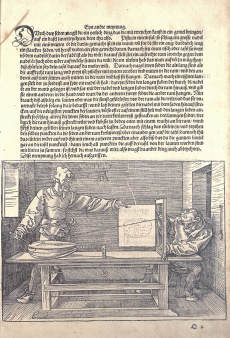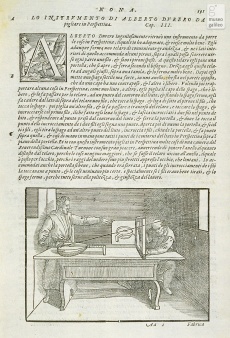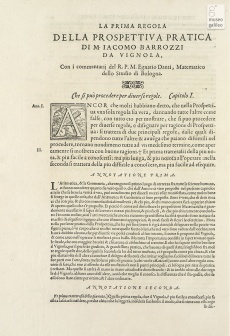Sportello
From Inventions
(Created page with '{{Template invention |nome= Name adopted by the inventor (in German ''türlein''=little door) and translated literally by Italian Renaissance theoreticians as ''sportello'' (win…')
Newer edit →
Revision as of 10:13, 21 July 2010
Name adopted by the inventor (in German türlein=little door) and translated literally by Italian Renaissance theoreticians as sportello (window).
Contents |
Inventor
Albrecht Dürer (1471-1528)
Historic Period
1525
Description
Unlike the veil and the glass that merely simulated a window – providing results highly dependent on the artist’s skill at drawing - the sportello, as it was called in the Renaissance, materialized all of the elements concurring to form an image: the eye was a hook fixed in the wall, the visual ray was a string extending from the hook to the object, and the picture was a plane defined by the intersection of two strings crossing inside the frame. The perspective image of any point on the object was unmistakeably identified by the intersection of the “visual” string with the two crossed strings. The mechanics of this operation were so clear and instructive that the eminent mathematician Egnazio Danti adopted just this instrument to demonstrate "what the basis of perspective consists of", since in it, he states in his commentaries to Vignola’s Due regole [Two rules], "We see distinctly … the common intersection of the visual pyramid, and the plane that cuts it". With this instrument Daniele Barbaro declared he had drawn "in Perspective many things in a chamber of the Most Reverend Cardinal Turnone, to his great pleasure " (La pratica della perspettiva [The practice of perspective] Venice, 1569, X, III) and, to judge by its publishing success, the sportello must have been very widespread in both artists’ workshops and private collections. A picture of it appears, for instance, in the decorative cycle of the so-called "Stanzino delle Matematiche", the room arranged by Ferdinando I in the Uffizi to house the Medicean collection of scientific instruments. The instrument had only one drawback: the use of a string, which tended to sag when stretched too far, impairing the precision of a drawing and allowing only small, rather nearby objects to be drawn. Moreover, this limitation was noted by Dürer himself: “From now on I will teach how any visible object not too far away from the eye can be measured with three strings and transferred in this way to a painting..." (Underweisung der messung, Nuremberg, 1525, IV). To overcome this limitation, Egnazio Danti designed a variant that could be used to depict distant objects as well: "Since with that sportello of Alberto only small things, that are close by, can be drawn, I myself have made another one with sights, which can be used to draw in perspective anything no matter how distant it may be..." (Le due regole, Rome, 1583, III, p. 56).
Bibliographical Resources
Barbaro, Daniele. La pratica della perspettiva di monsignor Daniel Barbaro ...: opera molto utile a pittori, a scultori et ad architetti: con due tavole, una de' capitoli principali, l'altra delle cose più notabili contenute nella presente opera. In Venetia, appresso Camillo & Rutilio Borgominieri fratelli, 1569, IX, III.
Dürer, Albrecht. Underweysung der messung mit dem zirckel vnd richtscheyt in Linien ebnen vnnd gantzen corporen durch Albrecht Duerer zusamen getzogen vnd zu nutz aller kunstlieb habenden mit zu gehoerigen figuren in truck gebracht im jar. 1525. Gedruckt zu Nueremberg, Hieronymus Andreae, 1525.
Alberti Durereri Institutionum geometricarum libri quatuor: in quibus, lineas, superficies, et solida corpora, ita tractavit, ut non matheseos solúm studisosis, sed et pictoribus, fabris aerariis ac lignariis, lapicidis, statuariis, et universis demúm qui circino, gnomone, libella, aut alioqui certa mensura opera sua examinant, sint summé utiles et necessarii. Arnhemiae, Ex officina Iohannis Iansonii, 1606, IV.
Vignola, Giacomo Barozzi detto il. Le due regole della prospettiva pratica. Con i comentarij del R.P.M. Egnatio Danti". In Roma, per Francesco Zannetti, 1583, cap. III, p. 55.
Vignola, Giacomo Barozzi detto il. Le due regole della prospettiva prattica. Con i commentari del ... maestro Egnatio Danti. In Bologna, per Gioseffo Longhi, 1682.
Images
Author of the entry: Filippo Camerota



